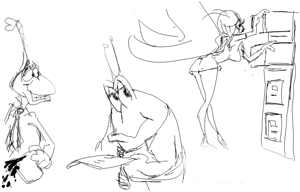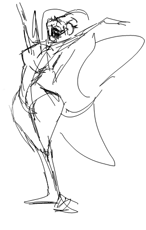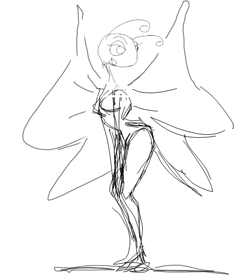Cartoon Production Deductions
I use to do all my storyboards by sketching panels on 3x5" blank white index cards and then I would lay out the sequences by sticking the cards up on big sheets of fiber board material. (Actually I use to use the back s of some surplus 2X4' acoustic ceiling tiles for my mounting boards). I would also put dialogue and other notes on strips of paper thumb tacked under the index cards. It worked Ok but was not really practical in today's world of virtual studios. For example at TGRS we actually work as collaborators in many different geographic locations. So when we are working on a board and want to show it for input we have to use the Internet and having the board converted to digital form works really well.
I once actually tried video taping the physical board walkthrough and converting the DV tape to QuickTime for streaming over the net, but I finally decided that using something with a timeline, like Flash, supports much better communication and it is much easier to use for making revisions. We still do most of our panel sketching on paper and then scan them into the computer and import them into Flash, but then we can also animate sections of the storyboards to create sort of an animatic because everything is digital at that point.

Our Flash storyboards get really pretty detailed because it becomes so easy to add scenes or shots and we not only put in any written dialogue but also we add SFX and Camera move notes, the Foley requirements, and even ideas for the musical scoring. I use to think it was a lot of extra work, but this is really a great way to plan a cartoon and work through a lot of the problems. It actually seems to save a lot of work on the backend with fewer "dead ends" and "deleted scenes". Also a lot of storyboards prove out that what seemed to be a good concept just wasn't that good or that funny and wasn't worth continuing. More often though the boards show weaknesses in a story or the presentation and they give you a place to make improvements before you get too invested in any one concept. The trick is to remember not to approach it like finished art but more gestural because the faster and easer it is to make the less you will mind making chances.
Certainly doing extra work in the production of a film should be avoided. After all animation is extremely labor intensive already. Which brings us to the question, are animatics extra work? Are they potentially a powerful tool or step in the process, that can be utilized to actually save you time and effort later in the production by letting you work out or adjust details, solve problems, and fine tune your vision of the final film prior to committing time and labor to efforts that will end up on the "cutting room" floor? We think they are well worth the time because there are sequences that just can’t be visualized and worked out with snapshot style boards only. Sometimes a rough animation version is so much better. And actually seeing boards with actual scratch dialog, SFX and music is really useful in determining if your story ideas will really work. I'll save the discussion of cartoon story flow and rhythms for a future posting.

I'm one of those people who educators classify as a visual learner, I think most artist are. I probably watched too much TV as a kid. Anyway, I like to visualize a story in my head and then I want to move to the visuals pretty fast during the writing stage, but I usually write a initial script first because I don’t have time to do the boards by myself these days, plus it helps to get more than one person doing the visualizations. I start with a situation, but actually, I start with a cast of characters. Once I have a good picture in my mind of the characters, really also understanding their complex personalities, I can start to visualize them in situations and then the stories start to flow. It is more like watching them and reporting their adventures then it is like writing a script. It probably stems back to the way I played as a kid. All the kids in the neighborhood would pick a character role and then we would act out stories; sort of improvisations.

At TGRS we rarely ever just write, or draw up a story idea and then just say “great, now we can make this cartoon ". It usually goes through many revisions. At first we really like the idea, and then usually after some time passing, we find places to change things. Then after some rework, we get frustrated with the story and have to put it away. I suppose that at any given time we have several episodes that are sitting around in some phase of "I'm tired of working on that one right now" or “This needs to sit until we can approach it again fresh later”. It's not that they aren't good ideas or at least potentially good ideas, but when we work on things for awhile, really intensely focused, we get too close to them and just need to distance ourselves and then come back for a second or third pass. Personally, I do the same thing when I'm animating a sequence, I never can just leave my work being satisfied after only one pass. It's a little like cooking, it just isn't ready until it's ready so there is no sense trying to rush.
I once actually tried video taping the physical board walkthrough and converting the DV tape to QuickTime for streaming over the net, but I finally decided that using something with a timeline, like Flash, supports much better communication and it is much easier to use for making revisions. We still do most of our panel sketching on paper and then scan them into the computer and import them into Flash, but then we can also animate sections of the storyboards to create sort of an animatic because everything is digital at that point.

Our Flash storyboards get really pretty detailed because it becomes so easy to add scenes or shots and we not only put in any written dialogue but also we add SFX and Camera move notes, the Foley requirements, and even ideas for the musical scoring. I use to think it was a lot of extra work, but this is really a great way to plan a cartoon and work through a lot of the problems. It actually seems to save a lot of work on the backend with fewer "dead ends" and "deleted scenes". Also a lot of storyboards prove out that what seemed to be a good concept just wasn't that good or that funny and wasn't worth continuing. More often though the boards show weaknesses in a story or the presentation and they give you a place to make improvements before you get too invested in any one concept. The trick is to remember not to approach it like finished art but more gestural because the faster and easer it is to make the less you will mind making chances.
Certainly doing extra work in the production of a film should be avoided. After all animation is extremely labor intensive already. Which brings us to the question, are animatics extra work? Are they potentially a powerful tool or step in the process, that can be utilized to actually save you time and effort later in the production by letting you work out or adjust details, solve problems, and fine tune your vision of the final film prior to committing time and labor to efforts that will end up on the "cutting room" floor? We think they are well worth the time because there are sequences that just can’t be visualized and worked out with snapshot style boards only. Sometimes a rough animation version is so much better. And actually seeing boards with actual scratch dialog, SFX and music is really useful in determining if your story ideas will really work. I'll save the discussion of cartoon story flow and rhythms for a future posting.

I'm one of those people who educators classify as a visual learner, I think most artist are. I probably watched too much TV as a kid. Anyway, I like to visualize a story in my head and then I want to move to the visuals pretty fast during the writing stage, but I usually write a initial script first because I don’t have time to do the boards by myself these days, plus it helps to get more than one person doing the visualizations. I start with a situation, but actually, I start with a cast of characters. Once I have a good picture in my mind of the characters, really also understanding their complex personalities, I can start to visualize them in situations and then the stories start to flow. It is more like watching them and reporting their adventures then it is like writing a script. It probably stems back to the way I played as a kid. All the kids in the neighborhood would pick a character role and then we would act out stories; sort of improvisations.

At TGRS we rarely ever just write, or draw up a story idea and then just say “great, now we can make this cartoon ". It usually goes through many revisions. At first we really like the idea, and then usually after some time passing, we find places to change things. Then after some rework, we get frustrated with the story and have to put it away. I suppose that at any given time we have several episodes that are sitting around in some phase of "I'm tired of working on that one right now" or “This needs to sit until we can approach it again fresh later”. It's not that they aren't good ideas or at least potentially good ideas, but when we work on things for awhile, really intensely focused, we get too close to them and just need to distance ourselves and then come back for a second or third pass. Personally, I do the same thing when I'm animating a sequence, I never can just leave my work being satisfied after only one pass. It's a little like cooking, it just isn't ready until it's ready so there is no sense trying to rush.

0 Comments:
Post a Comment
<< Home